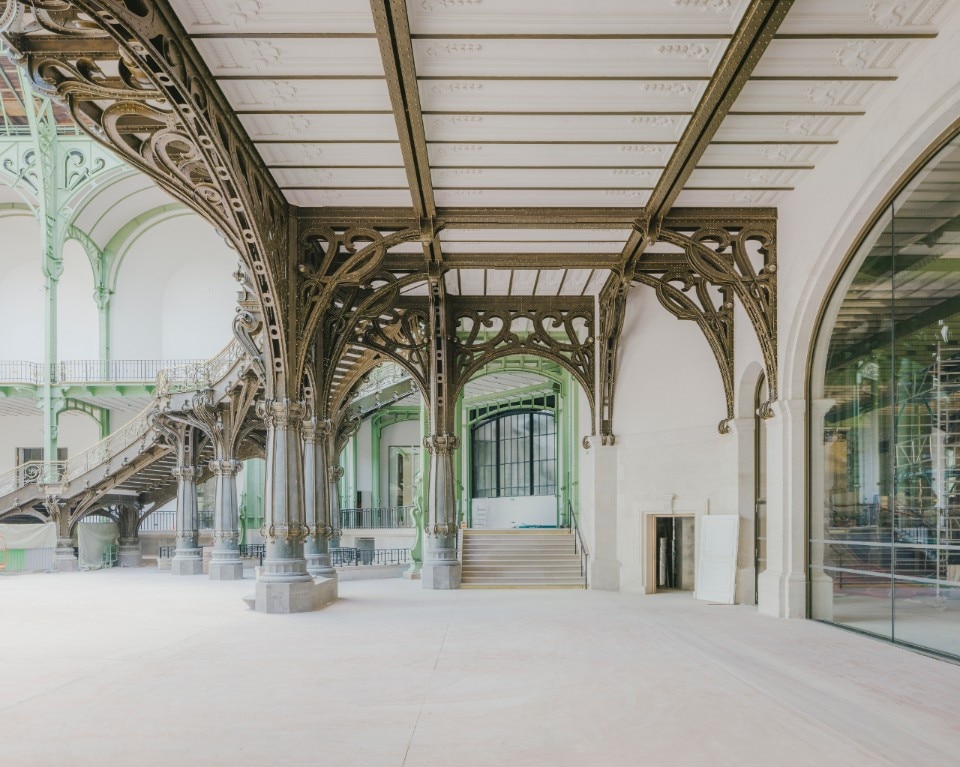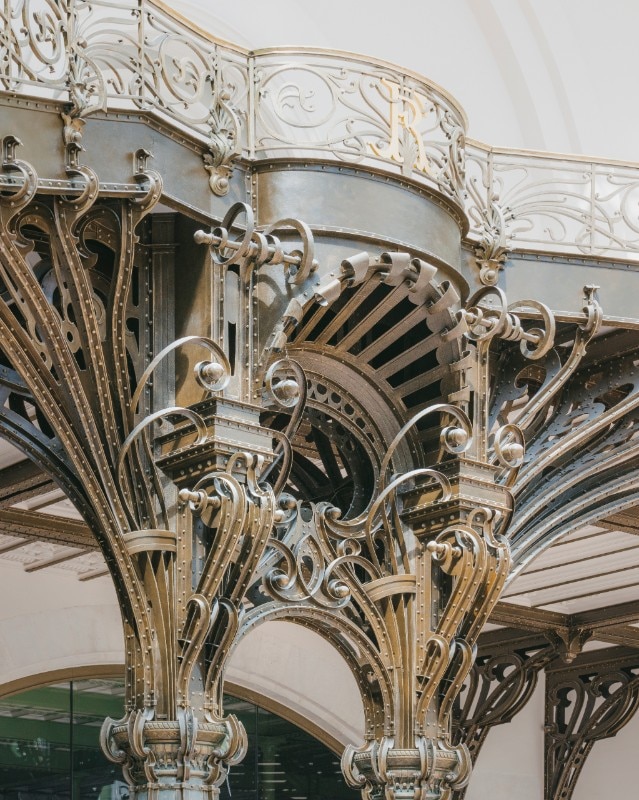The Grand Palais represents a certain idea of France, encompassing both its grandeur and adventures. Built in record time from the ashes of the Palais de l’Industrie, this massive complex designed to host the 1900 Universal Exhibition has stood as a new symbol of modernity since its inauguration. As large as the palace of Versailles, it embodies an architectural vision that combines the ideas of splendor and progress, fully represented in its steel and glass structure of the Nave. It stands as the largest in Europe and its glass vault defines an ethereal, suspended volume that still amazes contemporary visitors today. However, behind the pragmatic exhibition space and sumptuous decorations lies an unsuspected facet: a pastiche.
Built in only three years following an architecture competition in 1896 that did not result in a clear winner, the Grand Palais is actually the sum of three separate projects constructed side by side by three different architects: Henri Deglane, who designed the nave, Louis-Albert Louvet, in charge of the central block with its grand staircase, and Albert Thomas, who designed the Palais de la Découverte. All was then brought together by architect Charles Giraud coordination. A forced marriage made necessary by a tight timeline, which transformed the Grand Palais into an integrated trigamy, both in the implementation phase and in the final spatial result of the completed work.

“The Grand Palais is like a Swiss Army knife,” François Chatillon tells us, in his dual role as founder of Chatillon Architectes, the architectural firm leading the current renovation of the entire complex, and as architecte en chef des monuments historiques (ACMH), a category of state officials hired through a special selection process and responsible for protecting French heritage. Originally designed and used as an exhibition space, the Grand Palais has proven its versatility over the decades, adapting to functions ranging from racetrack to military hospital, demonstrating its ability to serve more purposes than just an exhibition space. This adaptability, and the consequent identity vision for the monument's future, is central to the questions about the building’s fate raised by architects and institutions. "The dual challenge today," Chatillon continues, "involves both the retrofitting of the monument and a renovation that keeps it in step with our times, while projecting it toward the future.”

For this reason, the very first comprehensive renovation of the building was deemed the necessary. A number of technical issues had led to the closing of some areas, and the lack of compliance with safety norms had made the structure unfit for hosting events. Fully closed to the public on March 21st, 2021, as we write the Nave of the Grand Palais is in the final stages of a renovation project that reveals glimpses of the completed work. The deadline is looming: the Paris 2024 Summer Olympic and Paralympic Games. However, for the opening of the entire complex we will have to wait until 2025.
What appearance should be given to an history monument that has already faced threats of destruction - fist in the great fire of 1944 during the liberation of Paris, then when Minister of Cultural Affairs André Malraux intended to raze it to let Le Corbusier build a museum symbol of the 20th century? In the design vision that François Chatillon shared with us, the priority is to restore the monument's intelligence of form by reinstating its unity and coherence of space and preserving its functions. This ideal materializes in the renewed fluidity between the three blocks and in the desire to restore the Grand Palais's magnificence through the renovation of all elements, from statues and mosaics to balustrades, which have always defined its grandeur.
A monument carefully restored to its exceptional splendor, with a structure that by itself can evoke the power of its own uniqueness and grandeur.

During our preliminary visit inside, while constructions progress at a brisk pace to meet the Olympics deadline, what stood out was the freedom of the eye to penetrate deeply through the monument's layers and advance through an enhanced play of perspectives. The dividing walls built in 1937 to separate the three buildings have been removed. This not only offers a clear line of sight from the Rotonde d’Antin of the Palais de la Découverte to the Nave but also promotes natural light and smooths the visit.
The splendor of the Nave is brought back to life through careful restoration work and a harmonious color palette. A coral-colored technical floor interacts with the rediscovered green of the colonnades and balustrades and the warm white, with a hint of pink, of the walls. The obscured glass 17,500-square-meter ceiling has been replaced with clear glass to let the sky and its changing hues into the architectural structure. Optimizing thermal properties was a major challenge due to the constraints of the building's historic nature; energy efficiency was achieved through solutions such as flooring and technical double-glazed windows in the vault. To overcome the system design challenge, the Grand Palais favored the construction wall systems, eliminating the need for drop ceilings to preserve the clean architectural lines of the vaults in the galleries.
The Grand Palais has proven its versatility over the decades, adapting to functions ranging from racetrack to military hospital, demonstrating its ability to serve more purposes than just an exhibition space.

In François Chatillon's words, the desired effect is to "reveal the richness of the monument's history," favoring continuity over disruption. This approach extends to preserving the mezzanine floors created by Pierre Vivien in the side galleries during the 1960s, as they are viewed as an efficient and integrated layer of the building. This vision contrasts with the project from the Parisian firm LAN, which was chosen as the winner of the Grand Palais renovation competition in 2014 but subsequently dismissed in 2020 - allegedly with presidential involvement - because their solution was deemed overly grandiose in post-Covid times. It is unclear whether technical issues that arose during the project and the associated constraints of the budget - 466 million euros, 288 million of which were funded by the state - and deadlines, with an unmovable Olympic appointment, also played a role in this decision.
What impression of France will the new Grand Palais offer us? Certainly, that of a monument carefully restored to its exceptional splendor, with a structure that by itself can evoke the power of its own uniqueness and grandeur. Perhaps it will not offer as much of a sense of new interpretation or a bold approach that could add a fresh layer to the monument's already rich identity. But, inclusive and diverse, the Grand Palais will at least on paper maintain its desire to be a destination for Parisians, thanks to numerous spaces and amenities open to the public even without a ticket. And a promise to provide a new destination for leisurely strolls in one of the most exclusive areas of the city.










